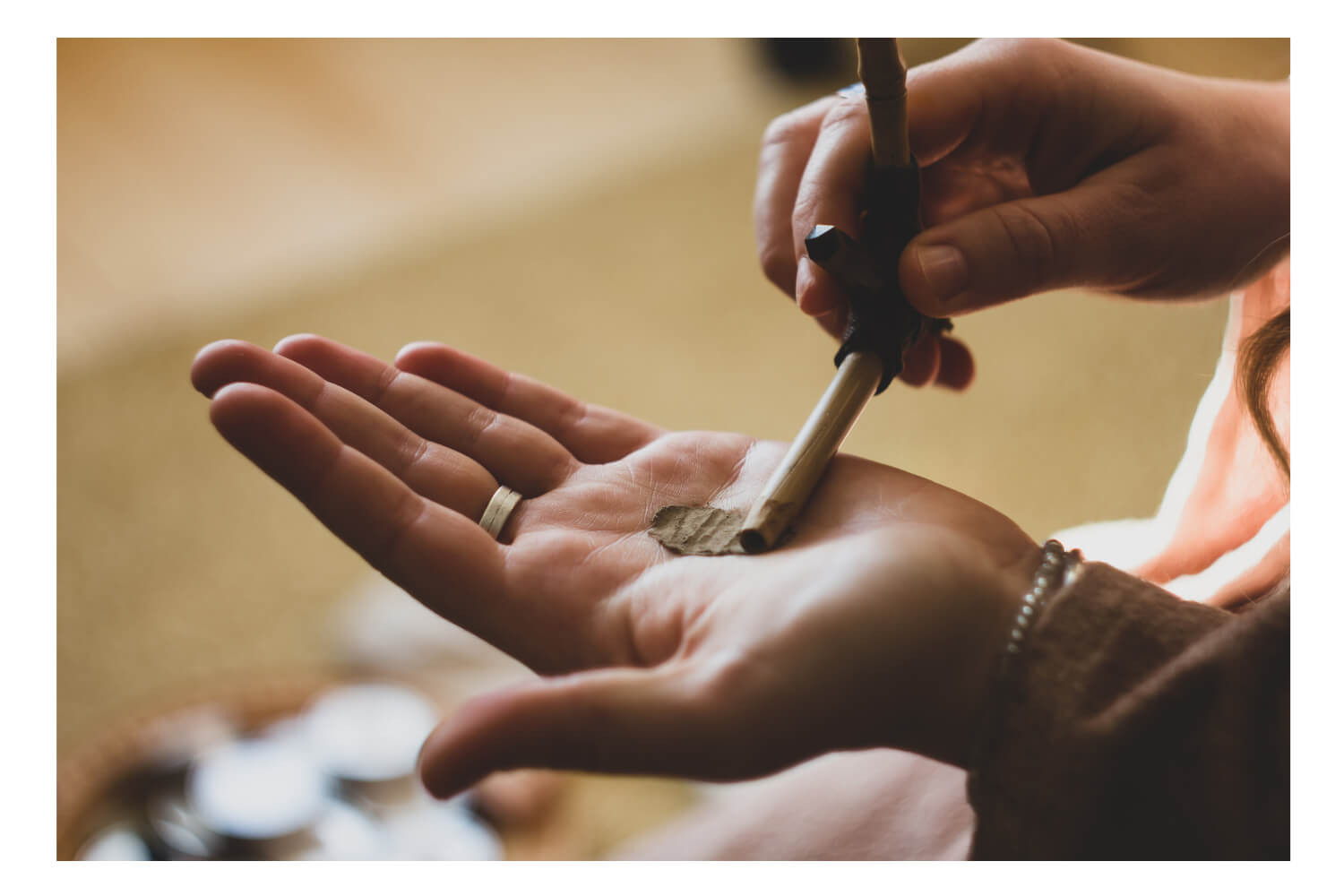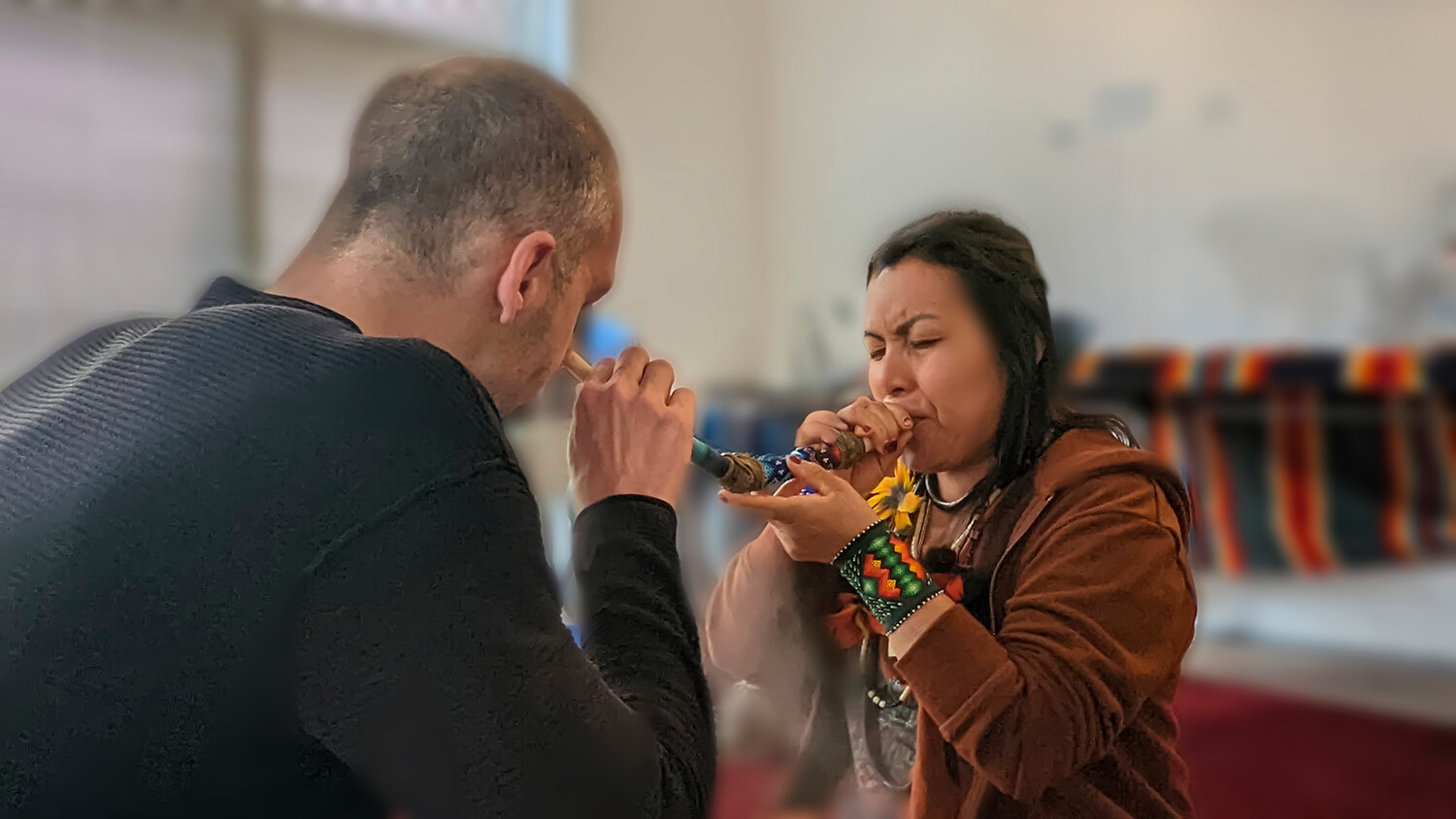What is rapé? Everything and more about this sacred snuff. Rapé, pronounced as ‘ha-peh’ or ‘rapay’, is a finely ground shamanic snuff from the deep jungles of the Amazon region. It has been used for thousands of years by indigenous tribes such as the Kaxinawá, Nukini, and Yawanawá for ritual, medicinal, and spiritual purposes. Rapé is considered a sacred medicine that can help overcome physical, psychological, and emotional blockages and provide insight into parallel worlds.
The name ‘Rapé’ may come from the Spanish word ‘raspar’, meaning to scrape or rasp, or from the Tupi word ‘hapi’, meaning to blow. Although the exact origin of rapé is unknown, it is believed that this sacred snuff was first used by the Tupi-Guarani people of Brazil.

What are the effects of rapé?
Rapé can help release physical and emotional tensions and achieve a relaxed and peaceful state. Additionally, rapé can provide energy, induce visions, and contribute to a sense of clarity and focus. It is known for its purifying and mucus-dissolving effects. The mental and physical effects of rapé can last from a few minutes to an hour. The exact effects vary depending on the specific composition of the rapé – different medicinal plants are used, resulting in various types of rapé with different effects.
The physical and energetic impact of rapé
Rapé works immediately after administration through the nose, with the active components quickly absorbed into the bloodstream. This can trigger a number of physical reactions seen as part of the cleansing process, in addition to the mental effects. Energetically, rapé is considered a means to ‘ground’ and stop thoughts, supporting meditation and inner focus. Traditionally, it is used to purify the energy system and remove blockages.
How do you use rapé?
Rapé can be used in various ways. Traditionally, it involves two people: a receiver and a blower. The blower uses a special pipe, the tepi, to blow the rapé into the user’s nose. You can also blow rapé into your own nose with a kuripe, which is convenient for personal use. Rapé is traditionally blown into both nostrils. For a first-time use, a dose the size of a pea is usually used per nostril. Depending on how your body reacts, you can adjust the dose next time.
Thus, rapé can be used alone or with another person to experience its effects. In shamanic tradition, it is often used in a ceremonial setting. Ceremonies with this sacred plant medicine are also sought after in the Western world. But how does a rapé ceremony work?

How do you perform a rapé ritual or ceremony?
To perform a rapé ceremony, a quiet space is often created first where participants can comfortably open up to the experience. Then, the rapé is carefully prepared, and prayers or intentions are expressed, asking for healing or guidance. The shaman uses a tepi (blowpipe) to gently blow the rapé into each participant’s nostrils, a process symbolizing the reception of blessings and powers from the plant spirits.
After administration, time is taken for silence and reflection, allowing participants the opportunity to experience their inner journeys. The ritual often ends with the sharing of experiences and expressing gratitude. A rapé ritual or ceremony is a spiritual process aimed at healing, purification, and connection with the spiritual world, often guided by an experienced shaman or practitioner. It is important to maintain respect and care for the participants and the spiritual essence of rapé throughout the process.
Where does rapé come from?
Rapé originates from the Amazon region, where it has been used for thousands of years by indigenous tribes such as the Katukina, Yawanawa, Kaxinawa (Huni Kuin), Nukini, Kuntanawa, Apurina, Ashaninka, and Matses. These tribes each produce their own specific rapé blends and have unique methods of preparation, often accompanied by ritual songs and ceremonies.
How is rapé made?
Rapé is prepared with great care and attention, traditionally using the ash of specific trees and plants, mixed with Rustica. The process begins with selecting and purifying the wood (often Tsunu or Cumaru), which is then burned in a ritual fire. The remaining ash, rich in active substances and minerals, is carefully collected and ground into a fine powder.
Another key ingredient in rapé is Nicotiana rustica, also known as mapacho. This is a completely different plant than the Nicotiana tabacum used in cigarettes. The leaves of Nicotiana rustica are not burned, but dried and ground into powder.
In addition to mapacho, plants such as mint, sananga, or bobinsana may be added to create unique blends, each with its own specific properties and intentions. These are burned in a specific way, and the remaining ash is carefully collected and sieved to remove impurities.
The medicine man determines the exact ratio between Nicotiana rustica, ash, and all other elements. The entire production process is carried out in a ritual manner, in silence and with pure focus and intention. Each tribe has its own secret recipe and technique for making their unique rapé blend.
What is the difference between Nicotiana Rustica and Nicotiana Tabacum?
Nicotiana Rustica and Nicotiana Tabacum have some important differences. Nicotiana Rustica, also known as mapacho, is the type traditionally used for making rapé. Nicotiana Rustica has smaller leaves and produces less yield than Nicotiana Tabacum, but is valued for its strong, spiritual effects, providing a unique and powerful rapé experience. Nicotiana Tabacum, on the other hand, is the plant mainly used for making cigarettes and other smokable products, with larger leaves and a lower nicotine content.
The spiritual meaning of rapé
Rapé is more than just a medicinal product for the indigenous peoples of the Amazon. It is deeply rooted in their spiritual practices and is seen as a way to communicate with the spiritual world. The use of rapé is often accompanied by rituals aimed at healing, purification, and obtaining visions. These practices, led by shamans or spiritual leaders, affirm the sacred relationship between humans and nature. For the indigenous tribes, rapé symbolizes the cycle of life and death, unity with nature and the universe, and the ongoing quest for knowledge and wisdom.
Preparation and methods of using rapé
The right approach and intention are important when using rapé. Preparing yourself by taking rest and setting clear intentions can deepen the experience. Rapé can be administered in various ways: traditionally by another person with a blowpipe, or by yourself with a kuripe. Each has its own ritual and impact, with direct administration by another often felt as more intense.
Authentic rapé shopping at Next Level
At Next Level, we offer a carefully selected assortment of the best rapé blends, directly sourced from various indigenous tribes of the Amazon region. We have built good relationships with members of the Apurina, Huni Kuin, Kuntanawa, Nukini, Puyanawa, Shawandawa, and Yawanawa tribes, and consider it an honor to offer their sacred medicine worldwide.
The diversity of rapé varieties reflects the rich knowledge and traditions of the indigenous peoples. Our rapé is of the highest quality, prepared according to traditional shamanic methods. Each variety is tested by ourselves. Whether you’re looking for the strongest rapé for profound experiences, or a milder blend for daily use, in our shop you will find the best rapé for every need.
Personal experiences with rapé
Many users share experiences about how rapé helps them in their spiritual growth and personal transformations. Often we hear how it helps people let go of old baggage, gain new insights, better understand themselves, and feel more connected to the earth. Some describe the effect of rapé as a kind of instant meditation. Many use it as a tool to relax more easily and deeply. Our advice is to always treat this plant medicine with respect and use it in the same way as the indigenous tribes who have been making and using it for spiritual and medicinal purposes for thousands of years.
Is rapé legal?
In most countries, rapé is legally available.
Scientific research on rapé
Recent scientific research on rapé is still limited, but some studies point to the potential therapeutic benefits of Nicotiana rustica, such as anti-inflammatory and neuroprotective properties. However, the addition of other plant ingredients and ash makes each rapé blend unique, and the effects can vary greatly. Researchers emphasize the importance of further studies to understand the exact functioning of rapé in relation to the physical and spiritual experiences reported by users.
Does rapé have side effects?
Although rapé is generally considered safe for responsible use, it can have some side effects such as nausea, dizziness, or an increased heart rate. Rest assured: this does not always occur and not in everyone, and as you use rapé more often, your body will react less intensely to the initial stimulation. You become accustomed to the sensations and the action of the medicine. However, this does not affect the strength or effectiveness of the substance. No tolerance develops in the sense that you would need more and more to experience the effect. According to shamans and users, the physical reactions contribute to the cleansing effect of rapé; you thereby release old things and stuck energies.
Although rapé can be a powerful tool for spiritual and physical healing, the combination with alcohol or drugs, in the case of certain medical conditions, or use during pregnancy or breastfeeding is discouraged. It is always important to listen to your body and adjust the dose if necessary. If you experience severe or persistent side effects, stop using rapé and consult a doctor.
Conclusion
Rapé is a sacred plant medicine that has been used for thousands of years by shamanic healers in the Amazon area. It is used as a powerful tool for cleansing processes and achieving a meditative state, always approached with respect for its strong spirit. Order your rapé online now and experience for yourself the purifying and transformative power of this sacred plant medicine from the heart of the Amazon.
